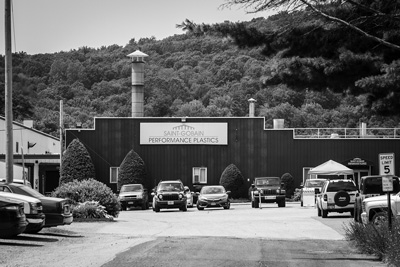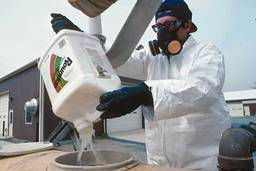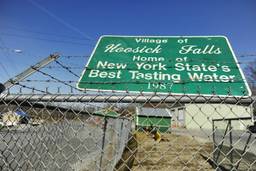An Industrial Chemical Poisoned Their Water, Now Upstate New Yorkers Want to Know What Replaced It
Tracy Frisch

Industry and government officials say perfluorooctanoic acid (PFOA), the toxic chemical blamed for contaminating drinking water supplies in Hoosick Falls, N.Y., and several other area communities, is no longer used in manufacturing in the United States.
But if PFOA has been phased out, what are industries using in its place?
People like Silvia Potter would like to know the answer to that question for the two Saint-Gobain Performance Plastics plants that still operate in Hoosick Falls. Potter says people in her community know “absolutely nothing” about the identity of the chemical or chemicals the company is using as a replacement for PFOA.
The lack of information has been frustrating for her and other members of their local advocacy group, NY Water Project.
“We only know what the company volunteers,” she says.
Perfluorooctanoic acid (PFOA), widely used for decades in the making of nonstick coatings like Teflon and a variety of other consumer products, is considered toxic even in tiny amounts. PFOA has been linked to cancer, birth defects and immune system dysfunction.
In 2006, eight major chemical companies, including 3M and DuPont, entered into a “voluntary stewardship agreement” with the U.S. Environmental Protection Agency (EPA) to phase out the production and use of PFOA by 2015. In its place, the industry switched to other chemicals in the same family that were deemed less hazardous by the EPA. But lately a variety of experts have begun to believe that these new chemicals also pose grave threats to human health.
Remarkably, it’s not clear whether government regulators — or even companies like Saint-Gobain — know the specific chemical identities of the substances being substituted for PFOA. In response to questions for this story, Saint-Gobain issued a statement saying it has relied on its suppliers to provide replacement chemicals for PFOA and that the composition of these chemicals “in the case of some suppliers may be proprietary.”
At public meetings, Potter says she and other members of NY Water Project have asked questions “at every appropriate moment” about what substances have replaced PFOA. But the information they have sought hasn’t been forthcoming.
“We’re just assured that everything is safe,” she says. “This concerns us, because things went wrong once. We wouldn’t even know about PFOA if it weren’t for Michael Hickey and his determination to get to the bottom of these mysterious illnesses. I believe the town owes Michael a debt of gratitude.”
Hickey’s father, who for many years worked at one of the local Saint-Gobain plants, died of kidney cancer. It was Hickey who thought to test the village of Hoosick Falls’ water for PFOA in 2014, revealing the village’s water contamination problem for the first time.
Whistleblower Michael Hickey personally tested Hoosick Falls’ water in 2014 after his father, John, died of kidney cancer. (Image: cbs6albany.com)
Change for the better?
PFOA is sometimes called C-8, for its chain of eight carbon atoms, each bonded to fluorine. The carbon-fluorine bond is extremely strong, making PFOA virtually indestructible. So it stays in the environment essentially forever: It doesn’t degrade in water or soil, and plants and animals don’t metabolize it.
By 2014, long after PFOA’s hazards to the environment and human health were first documented, the EPA classified the chemical and its cousin PFOS, which was widely used in firefighting foam, as “emergent contaminants.” But to this day, the federal government still doesn’t regulate them. And PFOA and PFOS, despite their notoriety, are only two of an estimated 3,000 to 6,000 other unique, highly fluorinated compounds.
The chemicals fall within the EPA’s purview under the federal Toxic Substances Control Act of 1976. But in the four decades since that law was enacted, the EPA has formally assessed only a tiny fraction of the more than 80,000 manmade chemicals on the market.
PFOA is part of a family of highly fluorinated chemicals known as polyfluoroalkyl substances, or PFAS. The chemicals are used to make consumer products resistant to water, grease or stains, such as Gore-Tex rain gear, Teflon no-stick cookware and Scotchgard stain-repellent for carpets and furniture fabrics. The EPA agreement that phased out PFOA and PFOS by 2015 didn’t stop the production and use of other highly fluorinated chemicals. Instead, the chemical industry has shifted from PFAS compounds with long chains of carbon and fluorine atoms, like PFOA, to shorter-chain compounds in the same family.
The industry had persuaded the EPA that short-chain PFAS chemicals are less persistent in the environment and less harmful to human health than their longer-chain predecessors. But experts who gathered at a conference this summer in Boston said the supposition that short-chain compounds are inherently safer is not warranted, even though the EPA has enshrined a distinction between short- and long-chain compounds in its policies.
“Every perfluorinated compound studied is causing problems,” says Linda Birnbaum, a toxicologist who serves as the director of the National Institute of Environmental Health Sciences and the National Toxicology Program.
A new generation of toxins
Birnbaum outlined the adverse effects of PFAS compounds in her keynote address at a June conference focused on these chemicals. The conference at Northeastern University brought together research scientists, government officials, lawyers, journalists, environmentalists and people from communities affected by PFAS contamination. In her presentation, Birnbaum explained even minuscule concentrations of perfluorinated compounds can pose risks.
According to conventional wisdom and principles of toxicology, Birnbaum said, poison is a function of dosage. So if a substance doesn’t pose risks at high doses, it’s considered unlikely to do so at low exposure. But with this class of chemicals, she said, low levels of exposure may induce biological effects even if high levels of exposure do not. This same dynamic also occurs with other endocrine-disrupting substances.
Andrew Lindstrom, an EPA research scientist who studies trace contaminants for the National Exposure Research Laboratory, told those attending the conference that industry is using short-chain substitutes in place of long-chain compounds like PFOA and PFOS. But he said the replacement compounds present multiple challenges.
First, he said, regulators and the public generally don’t know the specific identities of these chemicals, the quantities in which they’re being produced, their health effects or how long they’re retained in the human body. There is some data, though, on one short-chain PFAS compound produced under the product name GenX. DuPont introduced GenX in 2009 specifically as a safer replacement for PFOA for use in making Teflon and the stain-resistant and water-repellant coatings found in many consumer products.
In her series “The Teflon Toxin,” investigative journalist Sharon Lerner of the online magazine The Intercept details the numerous health and environmental hazards with this short-chain PFAS compound.
She writes that DuPont “submitted 16 reports [to EPA] of adverse incidents related to GenX between 2006 and 2013, describing experiments in which lab animals exposed to the chemical developed cancers of the liver, pancreas, and testicles as well as benign tumors. The industry research also tied GenX to reproductive problems, including low birth weight and shortened pregnancies in rats, and changes in immune responses.”

Sharon Lerner’s 13-part investigative series, The Teflon Toxin, was a finalist for the American Society of Magazine Editors Ellie Award. (Image: The Intercept)
Local companies stay mum
The question of what chemicals have replaced PFOA is moot in North Bennington, Vt., where a former Saint-Gobain plant — now blamed for contaminating the private wells of more than 200 homes — has been closed since 2002. But the issue remains a pressing one for neighbors of the Saint-Gobain plants in Hoosick Falls and the Taconic Plastics factory in Petersburgh, which has been blamed for PFOA contamination discovered last year that affected about 70 local water users.
Neither Saint-Gobain nor Taconic have revealed what chemicals they’re using in place of PFOA.
A call to Saint-Gobain did not yield a direct answer. The response came via Peppercomm, a New York City public relations firm. The firm provided a written statement attributed to Dina Pokedoff, Saint-Gobain’s director of branding and communication.
The statement said Saint-Gobain officials “reasonably rely on our suppliers” to provide replacement chemical for PFOA.
“As part of the U.S. EPA’s Stewardship Program that major raw material producers participated in, a primary goal was to eliminate PFOA from producers’ production processes and to identify replacements for PFOA,” the statement said.
But Saint-Gobain would not characterize those replacement chemicals more specifically. Instead it simply stated, “It is our understanding that the compounds that eventually replaced PFOA are reviewed by the U.S. EPA and in the case of some suppliers may be proprietary.” A query to Taconic Plastics, which used PFOA for years at its Petersburgh plant, brought a response from corporate counsel Laurie Mason. She declined to provide any information for this report, citing a Superfund investigation and pending civil litigation.
Company records detail hazards
Rob Bilott, a lawyer who brought a class-action suit against DuPont on behalf of people exposed to PFOA near the company’s plant in Parkersburg, W.Va., said the company has a history of professing the safety of highly fluorinated compounds to the public and government regulators — despite its own research demonstrating serious hazards. DuPont settled the Parkersburg suit for $235 million in 2004. But Bilott told participants in the June conference how the lawsuit opened a rare window into the normally secret world of an industrial corporation grappling with responsibility and liability for a nightmare chemical.
Through the legal process of discovery, DuPont handed over more than 100,000 pages of internal documents, which Bilott said he then submitted to the EPA with the goal of putting them into the public record. In that trove of papers, Bilott said he discovered that DuPont had been aware of PFOA’s dangers for several decades. The company studied the chemical in its laboratory program and also collected evidence by monitoring its workers. He said, as a result, DuPont had internally concluded in 1988 that PFOA was a human carcinogen.
According to Bilott, by the 1970s, DuPont already knew that PFOA was bio-persistent. In 1984, the company surreptitiously collected samples to test public drinking water for contamination and determined that PFOA was getting into public water supplies. More than 35 years ago, 3M’s rodent studies had linked PFAS with birth defects. When DuPont repeated the studies, it dismissed any association. But then it monitored a small number of pregnant employees exposed to PFOA. Two women out of a sample of eight or ten gave birth to babies with the same type of unusual birth defects, he said.

To read the The New York Times Magazine’s 2016 profile on Rob Bilott, click here. (Image: The New York Times Magazine)
In the late 1980s DuPont established its own action level of 500 parts per trillion for PFOA in drinking water. That’s 100 times lower than the threshold of 50 parts per billion that New York was using as a fallback when PFOA was first found in Hoosick Falls’ drinking water in 2014, prior to EPA’s intervention in late 2015 to warn the public not to drink the village water.
The EPA first set a guidance level of 400 ppt for short-term exposure to PFOA in drinking water in 2009. In 2016, the agency established 70 ppt as a guideline upper level for long-term exposure, and New York followed suit.
Last year, after PFOA was detected in North Bennington wells, Vermont established a drinking water enforcement standard of 20 ppt.
Contamination spread widely
Jason Galloway, an Ohio State University graduate student who grew up along the Ohio River, told conference participants he became interested in determining the geographic extent of PFAS contamination from DuPont’s Parkersburg plant, now operated by DuPont spinoff company Chemours. Galloway teamed up with Lindstrom, the EPA scientist, who has sensitive analytic equipment for detecting PFAS, and went out in a kayak to collect water samples.
The plant’s air emissions are only monitored within a 2-mile radius, but some of Galloway’s samples taken much further away contained PFOA. In the direction of prevailing wind, to the northeast, he found PFOA at 100 ppt 15 miles from the plant. At a distance of more than 25 miles, PFOA was still detected, though concentrations dropped to 10 ppt.
Twenty miles north of the plant, Galloway also found GenX, though the short-chain PFOA replacement had only been used for a short time. Lindstrom and his collaborators also detected GenX at a concentration of 661 ppt in the drinking water supply of Wilmington, N.C., where they collected samples downstream of another DuPont-owned factory operated by Chemours.
The EPA has estimated, based on its monitoring of large public water systems, that PFOA and other long-chain perfluorinated compounds are in the drinking water of 6 million Americans.
But Harvard environmental engineering professor Elsie Sunderland told participants in the Boston conference that this number seriously underestimates the magnitude of the problem, because about 90 million people rely on private wells or small public water systems that aren’t subject to EPA monitoring.
Sunderland also questioned whether the testing methodologies used by water systems to comply with EPA’s requirements are sensitive enough to find these chemicals. PFAS compounds can cause health effects at levels as low as 1 ppt, she said.
Pushing for a phase-out
Arlene Blum, an environmental chemist who founded the Green Science Policy Institute, says a body of research now contradicts DuPont’s claim that short-chain PFAS compounds are safe and environmentally preferable to longer-chain compounds like PFOA. Using a science-based approach — convening scientific experts, motivating needed studies, and publishing research findings in peer-reviewed journals — the Green Science Policy Institute has embarked on a new campaign to eliminate six classes of harmful chemicals. PFAS is the first class the group is targeting.
The institute’s approach builds on the Madrid Statement, which calls for limiting PFAS as a class because the chemicals pose numerous serious hazards that make them unsuitable for production and use. In 2015, 230 scientists from 38 nations signed the Madrid Statement, which was published with references in the peer-reviewed journal Environmental Health Perspectives. Blum says this class-wide strategy would prevent “regrettable substitutions” like those that scientists fear are occurring with the new short-chain PFAS compounds.
So far, at least 40 companies have been persuaded to stop using all PFAS compounds — both long- and short-chain — in clothing and textiles, says Blum. “Our big hope is that the military will do the same.” Despite widespread water and soil contamination on military bases from the use of PFOS-containing firefighting foam, the Pentagon has continued to procure highly fluorinated products for this purpose, she says.
Detailing health risks
The most definitive information on how PFOA exposure can affect human health comes from studies of 70,000 people living near a DuPont chemical plant in Parkersburg, W.Va. As part of the settlement in the large class-action lawsuit brought by Bilott against DuPont, three epidemiologists approved by both sides studied this population, which also received free health monitoring. DuPont agreed not to fight personal injury suits from area residents who experienced these health problems.
The data indicated a probable association between PFOA exposure and kidney cancer, testicular cancer, ulcerative colitis, thyroid disease, high cholesterol, and pregnancy-induced hypertension. Although other effects may occur, they were not statistically significant in this population. As endocrine disruptors, PFAS compounds affect hormonal systems. This can cause of a cascade of effects, because hormones act as signals to start, stop and otherwise regulate many physiological processes.
Courtney Carignan, a reproductive environmental epidemiologist at Harvard, noted that PFAS compounds affect thyroid function. She says adequate thyroid levels are critical for brain development and maturation in the developing fetus and during childhood.
PFAS compounds also are associated with an autoimmune hypothyroid marker. PFOA also disrupts sex hormones, for example by depressing testosterone levels. At the blood concentrations found in children in the Ohio River valley where DuPont’s Parkersburg’s plant contaminated drinking water, PFOA exposure affects mammary gland development in the developing fetus. Later in life, prenatal exposure may impair a woman’s capacity to breast feed and predispose her to breast cancer.
Alan Ducatman, a professor of medicine and public health at West Virginia University, suggests other mechanisms through which PFOA can cause developmental problems. He says studies show PFOA induces problems with fat metabolism in rodents and disrupts cholesterol metabolism in humans. According to Ducatman, cholesterol is a sterol, and the disruption of sterol metabolism is associated with developmental abnormalities.
Highly fluorinated compounds also affect the immune system in complex ways. Birnbaum cited a long-term study of mother-child pairs in the Faroe Islands, which are part of Denmark. In that study, children whose mothers were in the top 20 percent for exposure to PFAS compounds couldn’t mount a normal immune response to vaccination.
In pregnant women, perfluorinated compounds are carried from the placenta to the fetus, and breast milk is a source of exposure for children.
Ongoing exposure
Cathy Dawson, an operating room nurse who’s lived in Hoosick Falls for 30 years, brings a health orientation to the NY Water Project. When she first “heard the rumblings” about PFOA and saw a notice about it in her village water bill, she said she didn’t pay much attention. But then she messaged Michael Hickey. As a boy, he and his parents and siblings were her next-door neighbors when Dawson first moved to Hoosick Falls. Hickey’s response propelled her into action.
“Michael filled me in on everything that was going on, and told me about his research,” she recalls. Picking up where he left off, she did her own research.
What she learned left her outraged.
“A lot of people are afraid of the cancers” associated with PFOA, Dawson says. “But something like arthritis impacts people day to day with pain and disfigurement. PFOA is also known to cause cranial-facial abnormalities, and there are all the endocrine disorders. Studies have also linked PFOA to seizures. From a health-care perspective, it’s awful.”
NY Water Project’s big push now is to get the village a new water supply. Although state officials say a new filtration system is now keeping PFOA out of tap water, the village’s water comes from underground wells near the Saint-Gobain plant on McCaffrey Street, and the wells remain heavily contaminated. But water isn’t the only part of Hoosick Falls’ environment affected by industrial pollution. Portions of the village that were contaminated by Saint-Gobain’s plants are on track to be designated a Superfund site — they made it onto EPA’s National Priorities List in late July — and thus become eligible for federal cleanup funds.

The Saint-Gobain Performance Plastics plant on McCaffrey Street in Hoosick Falls, N.Y. (Image: Joan K. Lentini / Hill Country Observer)
For the people being affected, local pollution isn’t just a legacy issue. Dawson says she believes Saint-Gobain is still releasing industrial toxins into the air, and air deposition is one way that highly fluorinated compounds get into ground and surface water.
“The air still stinks, though it’s not as bad as it used to be,” she says, adding that odors from the plant are intermittent. “It smells like burning plastic, like if you left a Teflon pan on the stove.”
(“Trading old hazards for new? Mystery shrouds chemicals that replaced PFOA” was originally published by the Hill Country Observer and is reposted on Rural America In These Times with permission from the author. For additional background on the PFOA contamination of water supplies in communities in Upstate New York, Vermont and elsewhere see “Small Towns in New York and Vermont Share a Water Contamination Crisis, But Not an Official Response“ — also by Tracy Frisch and posted on this site in September.)








